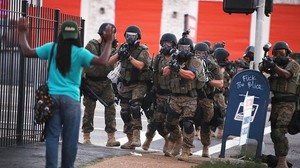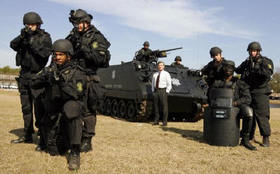The real story?
You want the narrative to be clean. You want the players to be clearly identified, the good guys and the bad guys. You want the moral of the story to be clear.
It never is.
It seemed to be at first, when the news came out of Ferguson, Missouri: unarmed black man, a teenager in this case, shot by white cop. But then some of the protesters turned violent, and then the video emerged showing Brown, only a few minutes before he died, shoving a store owner aside and walking out with a stolen $50 box of cigars. The autopsy report showed all the bullets hitting him from the front, which refuted one witness' claim that he was shot in the back, and was at least consistent with the theory that he was charging the officer.
That's too bad. Regardless of what happened with Brown, unarmed black man shot dead by white police officer is hardly an ahistorical occurrence. Oscar Grant died on the platform of the Fruitvale station along San Francisco's transit line, lying facedown with his hands behind his back; the police officer who shot him claimed that he accidentally used his gun instead of his taser. Ousmane Zongo stumbled upon a police investigation into a counterfeiting operation, and ran when a plain-clothes officer pulled a gun; after a short chase, the officer shot Zongo four times, twice in the back. Las Vegas police officer Brian Hartman shot Orlando Barlow from 50 feet away while Barlow was surrendering on his knees to four other police officers. Hartman claimed he thought Barlow was feigning surrender and was about to grab a gun. Barlow was unarmed. Hartman was cleared of any charges, but he and some other officers were fired when, after the incident, they had t-shirts printed up with BDRT in big letters on them. It stood for "Baby Daddy Removal Team."
And then, of course, there's Amadou Diallo. Four detectives saw him standing in a doorway, and called to him. He reached for his wallet, probably to show them identification. The detectives thought he was reaching for a gun, and fired 41 shots, hitting him 19 times.
But there was another narrative which emerged from Ferguson. Virtually everybody agrees that the police would have been hard-pressed to handle the situation in a worse way. Transparency is the key to crisis management, and the city's quick release of the autopsy findings and the robbery video would have gone a long way toward defusing the situation; the lateness of its arrival on the scene created skepticism as its truth, at least until that was no longer possible.
arrival on the scene created skepticism as its truth, at least until that was no longer possible.
Instead, the police decided to use a forceful approach. As someone commented, the picture at right looks more like something from Fallujah ten years ago.
And Ferguson isn't alone in bringing the heavy hardware to bear. The city of Neenah, Wis. (pop. 25,501) recently acquired a MRAP -- Mine-Resistant Ambush Protected armored vehicle. Why would the city of Neenah need a vehicle intended to ward off rocket-propelled grenades? Probably for the same reason that twenty-two states have obtained equipment to detect buried land mines.
Not that states and localities decided to double their tax rates in order to ensure they could repel an invasion from a small South American country. Between 2002 and 2011 the Department of Homeland Security handed out $35 billion in grants to state and local police, and as the Iraq war wound down, the US government was left with a crapload of surplus military equipment, most of which they gave away.
In that time, local police departments have acquired 432 MRAPs, 435 other armored vehicles, over 500 planes and helicopters, and nearly 94,000 automatic rifles. The armored personnel carrier Keene, NH, bought might come in handy the next time they have a homicide, although when that might be is up in the air; it had only three between 1999 and 2012. In the meantime, the police chief has promised that it will be used to patrol the town's Pumpkin Festival "and other dangerous situations."
 The "boys with toys" motif has become a central recruiting theme for police departments. The picture on the left isn't a squad from an army cavalry brigade, it's from the website of the Richland County, South Carolina, Sheriff's Department. An ad for a job with the Hobbs, NM, police department features the rate of pay imposed over pictures of the town's SWAT team engaged in various activities, none of them ever envisioned by people who grew up watching Mayberry, RFD.
The "boys with toys" motif has become a central recruiting theme for police departments. The picture on the left isn't a squad from an army cavalry brigade, it's from the website of the Richland County, South Carolina, Sheriff's Department. An ad for a job with the Hobbs, NM, police department features the rate of pay imposed over pictures of the town's SWAT team engaged in various activities, none of them ever envisioned by people who grew up watching Mayberry, RFD.
At first, it seemed as though the second narrative would have its own life. The shock of seeing what looked like an occupying army in Ferguson started a conversation, with congressmen, and not just liberal ones, talking about reigning in the militarization of the police.
But that's faded, too, caught in the backwash from the collapse of the first narrative, and the continued scenes of looting and rioting. That would be too bad, too, because perhaps the best lesson to be drawn from the Ferguson police department, which, in a town 67% black, boasts three black police officers and fifty white ones, is that if you're going to act like an occupying army, you're going to be treated like an occupying army.
Comments